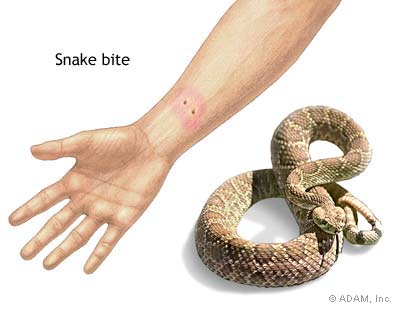Classifications of asthma severity
| Severity | Mild | Moderate | Severe & Life-threatening |
| Physical exhaustion | No | No |
Yes May have paradoxical chest wall movement |
| Talks in | Sentences | Phrases | Words |
| Pulse rate | Less than 100/min | Less than100-120/min | Greater than 120/min |
| Central cyanosis (bluish discolouration) | Absent | May be present | Likely to be present |
| Wheeze intensity | Variable | Moderate - Loud | Often quiet |
Care and treatment
- Sit the casualty comfortably upright
- Be calm and reassuring
- Do not leave casualty alone
With spacer:
- Shake inhaler and insert mouthpiece into spacer
- Place spacer mouthpiece in casualty's mouth and give 4 separate puffs of a blue/ grey reliever puffer
- Give 1 puff at a time
- Ask the casualty to breathe in and out normally 4 times after each puff
- Wait 4 minutes. If there is little or no improvement, repeat the above sequence
Without spacer:
- Shake inhaler
- Place mouthpiece in casualty's mouth. Fire 1 puff as the person inhales slowly and steadily
- Ask the casualty to hold that breath for 4 seconds, then take 4 normal breaths
- Repeat until 4 puffs have been given
- Wait 4 minutes. If there is little or no improvement, repeat the above sequence If still no improvement: - call Triple Zero (000) for an ambulance - continuously repeat reliever medication every 4 minutes until the ambulance arrives
Collapsed casualty:
- Call Triple Zero (000) for an ambulance
- If possible, assist with 4 puffs of a reliever
- If little or no immediate improvement repeat reliever medication every 4 minutes until the ambulance arrives
- Be calm and reassuring
- If no signs of life - cardiopulmonary resuscitation (CPR)
No harm is likely to result from giving a reliever to someone who does not have asthma.
In a severe asthma attack, rescue breaths will require much greater force to inflate the lungs.
Bites and stings
Venomous bites and stings are a type of injected poison. Many of Australia's creatures are particularly poisonous with eleven of the world's twelve most venomous snakes residing here. As for general poisoning prevention is better than cure, take care when in an area frequented by snakes and spiders and treat venomous sea creatures with respect.
Snakes
Australia's venomous snakes are regarded as dangerous because they frequently come in contact with humans.

Generally, the snakes with the most feared reputation is the variety of brown snakes. These snakes, as well as tiger snakes and the taipan are responsible for most of the fatal encounters with humans. Black snakes and death adders are also dangerous and are known to have caused deaths. Anti-venom is generally available for all species. In most cases, the snake strikes swiftly and injects venom below the surface of the skin into the tissues, which is then absorbed by the lymphatic system.
The lymphatic system is a network of tubes that drains fluid (lymph) from the body's tissues and empties it back into the bloodstream. Only rarely does the venom penetrate directly into the blood stream. As the venom is contained within the lymphatic system, the 'John Wayne Method' of slashing the wound and sucking vigorously, is of no value and should not be used under any circumstances.
Should you see a snake, LEAVE IT ALONE - do not attempt to kill it as all snakes are protected by law and besides, the creature will defend itself vigorously.
Stay clear of likely habitats and always pay special attention to young children playing near long grass and bush.
Research suggests only around 15% of people struck by poisonous snakes are envenomated, but always treat for the worst case and assume venom has been injected.
Signs and Symptoms:
- Puncture marks or parallel scratches on the skin - rarely any pain
- Anxiety
- Pale, cool skin with progressive onset of sweating
- Rapid, weak pulse
- Rapid, shallow breathing
- Breathing difficulties
- Blurred vision, drooping eyelids
- Difficulty swallowing and speaking
- Abdominal pain
- Nausea and/or vomiting
- Headache
- Collapse - progressing to a comatose state
Care and treatment
The main treatment for a snake bite is the application of a 'pressure immobilisation bandage' (PIB).
Apply a wide heavy crepe bandage (7.5 - 10 cm) over the bite site. Apply a second heavy crepe bandage starting from the fingers or toes and winding as far up the limb as possible. Immobilise the limb with a splint.
- Ensure safety
- Reassure and rest the casualty
- Call ambulance urgently
- Apply direct pressure over the bitten area
- Apply a PIB starting from over the bite site and then wind as far up the limb as possible to the armpit or groin
- Apply a second PIB commencing at the fingers or toes of the bitten limb and wind as far up the limb as possible to the armpit or groin
- Immobilise the limb with a splint
- Send any evidence of the snake to the hospital only if safe to do so
- Avoid washing the bitten area, as a venom sample may be obtained.
- Avoid elevating the limb.
- Do not use an arterial tourniquet.
- Do not remove the bandage and splint once it has been applied.
- Do not try to capture the snake.
- Do not cut the bitten area.
- Do not suck the bitten area.
If only one bandage available, start from the fingers or toes and wind as far up the limb as possible, including the bite site.